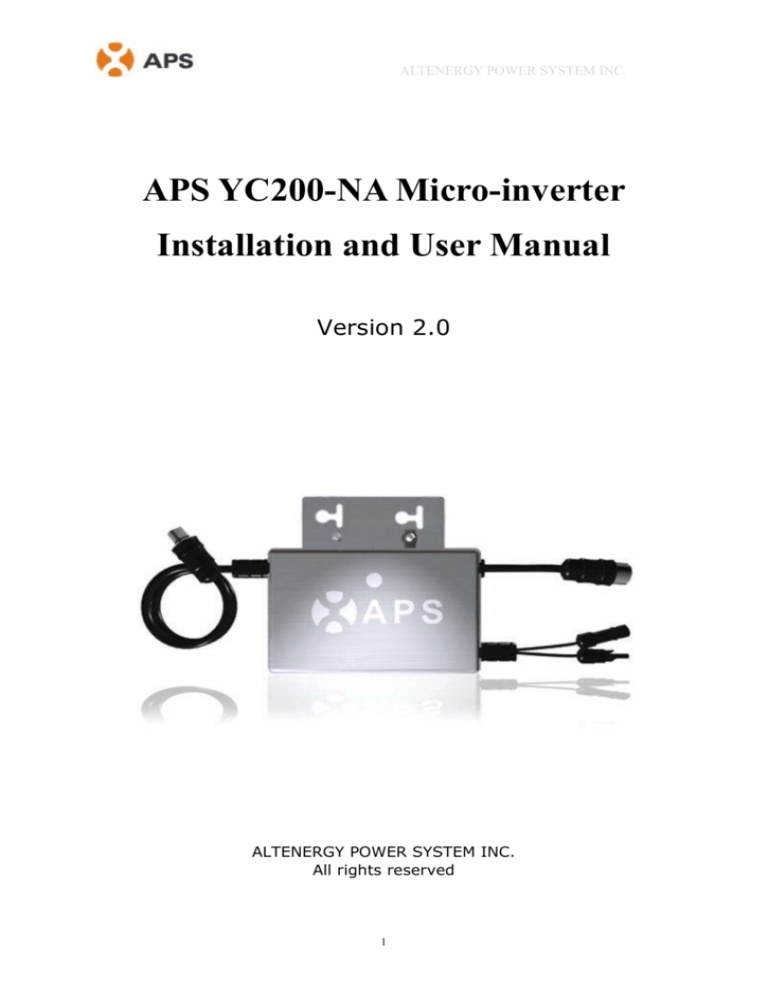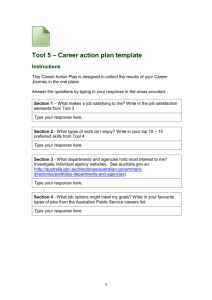
ALTENERGY POWER SYSTEM INC.
APS YC200-NA Micro-inverter
Installation and User Manual
Version 2.0
ALTENERGY POWER SYSTEM INC.
All rights reserved
1
ALTENERGY POWER SYSTEM INC.
Contact Information
ALTENERGY POWER SYSTEMS Inc.
19925 Stevens Creek Blvd, Suite 100
Tel: 408-9737888
Fax: 408-9737280
Cupertino, CA 95014
www.solaraps.com
info@solaraps.com
2
ALTENERGY POWER SYSTEM INC.
Table of Contents
1.
IMPORTANT SAFETY INSTRUCTIONS............................................................................................. 4
Safety Instructions ....................................................................................................................................... 4
2. APS micro-inverter System introduction ................................................................................................ 5
3. APS Micro-inverter System Installation ................................................................................................. 6
Installation Kits from APS .......................................................................................................................... 6
Required Parts and Tools ............................................................................................................................. 6
Installation Procedure.................................................................................................................................. 7
Step 1. Verify the grid voltage to match with micro-inverter rating ................................................... 7
Step 2. Install the AC Branch Circuit Junction Box ........................................................................... 7
Step 3. Connect the cables to the branch junction box ....................................................................... 7
Step 4. Attach the APS Micro-inverters to the Racking ..................................................................... 8
Step 5. Connect the APS Micro-inverter AC Cables .......................................................................... 8
Step 6. Install branch protective end cap ............................................................................................ 9
Step 7. Ground the micro-inverters .................................................................................................... 9
Step 8. Place the PV modules and connect Micro-inverter to PV Module ....................................... 10
Step 9. Complete the APS Installation Map ..................................................................................... 10
Step 10.
Start the operation ............................................................................................................ 11
4. Troubleshooting..................................................................................................................................... 12
Status Indications and Error Reporting ..................................................................................................... 12
Startup LED .......................................................................................................................................... 12
Operation LED ...................................................................................................................................... 12
GFDI Error: ........................................................................................................................................... 12
Other Errors ........................................................................................................................................... 12
Troubleshooting a Non-operating APS Micro-inverter ............................................................................. 13
5. Replacing a Micro-inverter ................................................................................................................... 14
6. Technical Data ....................................................................................................................................... 15
7. Appendix ............................................................................................................................................... 16
7.1
Sample Wiring Diagram-Single Phase ......................................................................................... 16
7.2
Sample Wiring Diagram – Three Phase........................................................................................ 17
7.3
Installation Map Template ............................................................................................................ 18
3
ALTENERGY POWER SYSTEM INC.
1.
IMPORTANT SAFETY INSTRUCTIONS
This manual contains important instructions to follow during installation and maintenance of the
ALTENERGY POWER SYSTEM (APS) micro-inverter. To reduce the risk of electrical shock and ensure
the safe installation and operation of the APS micro-inverter, the following symbols appear throughout this
document to indicate dangerous conditions and important safety instructions.
SAVE THESE INSTRUCTIONS– This manual contains important instructions for Models
YC200-NA that shall be followed during installation and maintenance of the micro-inverter .
WARNING: This indicates a situation where failure to follow instructions
may cause a serious hardware failure or personnel danger if not applied
appropriately. Use extreme caution when performing this task.
NOTE: This indicates information that is important for optimal operation.
Follow these instructions closely.
Safety Instructions
Only qualified professionals should install and/or replace APS Micro-inverters.
Perform all electrical installations in accordance with local electrical codes.
Before installing or using the APS Micro-inverter, please read all instructions and
cautionary markings in the technical documents and on the APS Micro-inverter
system and the PV-array.
Be aware that the body of the APS Micro-inverter is the heat sink and can reach a
temperature of 80°C. To reduce risk of burns, do not touch the body of the
micro-inverter.
Do NOT disconnect the PV module from the APS Micro-inverter without first
disconnecting the AC power.
Do NOT attempt to repair the APS Micro-inverter. If it fails, contact APS Customer
Support to obtain an RMA number and start the replacement process. Damaging or
opening the APS Micro-inverter will void the warranty.
4
ALTENERGY POWER SYSTEM INC.
2.
APS micro-inverter System introduction
The APS Micro-inverter is an inverter system for use in utility-interactive applications,
comprised of three key elements:
Altenergy Power Systems Micro-inverter
Altenergy Power Systems Energy Communication Unit (ECU)
Altenergy Power Systems Energy Monitor and Analysis (EMA) web-based
monitoring and analysis system
This integrated system improves safety; maximizes solar energy harvest; increases system
reliability; simplifies photovoltaic (PV) system design, installation, maintenance, and
management.
PV systems using APS Micro-inverters are safe to install and use. Micro-inverter
eliminates the high DC voltage (600V~1000V) in conventional PV inverter system. This
high DC voltage is lethal to installer and users.
It also may cause DC arcing and result in
fires.
PV systems using APS Micro-inverters are very simple to install. You can install
individual PV modules in any combination of module quantity, orientation, type, and power
rate.
The Ground wire (PE) of the AC cable is connected to the chassis inside of
the Micro-inverter, eliminating the installation of grounding wire.
The APS Micro-inverters maximize energy production from photovoltaic (PV)
arrays. Each PV module has individual Maximum Peak Power Tracking (MPPT) controls,
which ensures that the maximum power is exported to the utility grid regardless of the
performance of the other PV modules in the array. When PV modules in the array are
affected by shading, soiling, orientation, or mismatch, the APS Micro-inverter ensures top
performance from the array by maximizing the performance of each module within the
array.
The APS Micro-inverter system is more reliable than centralized or string
inverters. The distributed Micro-inverter system ensures that no single point of system
failure exists across the PV system. APS Micro-inverters are designed to operate at full
power at ambient temperatures of up to 65°C. The inverter housing is designed for outdoor
installation and complies with the IP65 environmental enclosure rating.
The APS Micro-inverter system provides smart system performance monitoring
and analysis.
The APS Energy Communication Unit (ECU) is installed by simply plugging it into any wall
outlet and providing an Ethernet or Wi-Fi connection to a broadband router or modem. After
installing the ECU, the full network of APS Micro-inverters automatically reports to the APS
Energy Monitor and Analysis (EMA) web server. The EMA software displays performance
trends, informs you of abnormal events, and controls system shutdown when it is needed.
5
ALTENERGY POWER SYSTEM INC.
3.
APS Micro-inverter System Installation
A PV system using APS Micro-inverters is simple to install. Each micro-inverter easily
mounts on the PV racking, directly beneath each PV module. Low voltage DC wires connect
from the PV module directly to the micro-inverter, eliminating the risk of high DC voltage.
WARNING: Perform all electrical installations in accordance with local
electrical codes.
WARNING: Be aware that only qualified professionals should install and/or
replace APS micro-inverters.
WARNING: Before installing or using an APS Micro-inverter, please read all
instructions and warnings in the technical documents and on the APS
Micro-inverter system itself as well as on the PV array.
WARNING: Be aware that installation of this equipment includes the risk of
electric shock.
WARNING: Do not touch any live parts in the system, including the PV array,
when the system has been connected to the electrical grid.
Installation Kits from APS
AC interconnect cable to branch junction box
Branch cable Protective end caps
Required Parts and Tools
In addition to your PV array and its associated hardware, you need to provide the following:
An AC connection junction box
Mounting hardware suitable for module racking
Sockets and wrenches for mounting hardware
Continuous grounding conductor and grounding washers
A Phillips screwdriver
A torque wrench
6
ALTENERGY POWER SYSTEM INC.
Installation Procedure
Installing the APS Micro-inverter System involves 10 key steps:
WARNING: Do NOT connect APS Micro-inverters to the utility grid or energize
the AC circuit until you have completed all of the installation procedures as
described in the following sections.
Step 1. Verify the grid voltage to match with micro-inverter rating
Step 2. Install the AC Branch Circuit Junction Box
Step 3. Connect the cables to the branch junction box
a. Put the unused end of the AC interconnector cable into the branch junction box.
The other end has a Female connector.
b. Place cable connecting to the point of utility interconnection into the branch junction
box.
c. Wire the conductors: L1- RED; L2 - BLACK; N – WHITE.
NOTE: Be sure to size the AC wire to account for voltage drop between the AC
branch circuit junction box and the point of utility interconnection.
The table below provides recommendations for wire size from the junction box at the
beginning of the Micro-inverter branch to the main load center based on distance.
Maximum external wiring distance (feet)
Wire (AWG)
14
12
10
8
6
10
77
122
194
308
490
Module number in branch
11
12
13
14
54
45
37
30
86
72
59
47
137
114
94
75
218
182
149
120
347
289
237
190
7
15
23
37
58
93
148
ALTENERGY POWER SYSTEM INC.
Step 4. Attach the APS Micro-inverters to the Racking
a. Mark the location of the micro-inverter on the rack, with respect to the PV module
junction box or any other obstructions.
b. If using grounding washers to ground the micro-inverter chassis to the PV module
racking, choose a grounding washer that is approved for the racking manufacturer. Install
a minimum of one grounding washer per micro-inverter.
c. Mount one micro-inverter at each of these locations using hardware recommended by
your module racking vendor.
WARNING: Do not mount the micro-inverter in a location that allows
exposure to direct sunlight. Allow a minimum of three centimeters between
the top of the roof and the bottom of the micro-inverter.
Step 5. Connect the APS Micro-inverter AC Cables
Each micro-inverter comes with a set of female and male connectors.
Through female and
male connectors, the micro-inverters can be connected to form one continuous AC branch
circuit.
a. Orient the first micro-inverter in each branch, which will be connected to junction
box, with its male connector facing the junction-box. The AC cable connecting
junction-box has a female connector. The micro-inverter can be mounted with either
side facing up depending on cable routing. Connect AC interconnect cable to the first
micro-inverter.
b. Check the micro-inverter rating label for the maximum allowable number of
micro-inverters on one AC branch circuit.
c. Plug the AC female connector of the first micro-inverter into the male connector of
the next micro-inverter, and so on, to form a continuous AC branch circuit.
WARNING: Do NOT exceed the maximum number of micro-inverters in an AC
branch circuit, as displayed on the unit label. Each micro-inverter AC branch
must be a dedicated branch circuit protected by a 15A maximum breaker.
8
ALTENERGY POWER SYSTEM INC.
Step 6. Install branch protective end cap
a. Install a protective end cap on the open female AC connector of the last
micro-inverter in the AC branch circuit.
b. Make sure all unused AC connectors are covered by protective end caps.
Step 7. Ground the micro-inverters
NOTE: If you already use grounding washers to ground the micro-inverter
chassis to the PV module racking as described in step 4, skip this step.
Each APS micro-inverter comes with a ground clamp that can accommodate a single
1.5mm2, 6mm2, or 16mm2 conductor. Check your local electrical code for grounding
conductor sizing requirement. Connect the grounding electrode conductor to the
micro-inverter ground clamp.
NOTE: The AC output neutral is not bonded to ground inside the
micro-inverter.
9
ALTENERGY POWER SYSTEM INC.
Step 8. Place the PV modules and connect Micro-inverter to PV Module
First connect the positively marked DC connector (female) from the PV module to the
negatively marked DC connector (male) of the micro-inverter. Then connect the negatively
marked DC connector (male) from the PV module to the positively marked DC connector
(female) of the micro-inverter. Repeat for all PV modules using one micro-inverter for each
module.
WARNING: Watch LED closely during connection
Three short GREEN blinks indicate a successful Micro-inverter startup.
If LED if OFF, reconnect DC connectors to get good contact.
If still OFF,
DO NOT USE THIS MICRO-INVERTER.
Step 9. Complete the APS Installation Map
Each APS Micro-inverter has a removable serial number label located on the mounting plate.
Peel the label off, and affix it to the respective location on the APS installation map.
The APS Installation Map is a diagram of the physical location of each micro-inverter in your
PV installation. You can use the blank map in the Appendix to record micro-inverter
placement for your system. When your map is complete, send it to APS as described below.
APS uses this information to provide you with detailed information about the performance of
your PV system and to allow you to see a graphic representation of your PV system on APS’s
EMA web-based monitoring and analysis system. Feel free to provide your own layout if a
larger or more intricate installation map is required.
10
ALTENERGY POWER SYSTEM INC.
To complete your map:
a. Each APS Micro-inverter has a removable serial number label located on the
micro-inverter. Peel the label off, and affix it to the respective location on the APS
installation map, which is available in the warranty card.
b. Send the installation map to APS after completion. See the contact information at the
beginning of this manual for a fax number, email address, and mailing address.
c. After APS creates a graphical view of your PV system on the EMA website, use the EMA
website to view detailed performance information for your PV system. Please go to
www.solaraps.com for more information on APS’s EMA web-based monitoring and analysis
system.
Step 10.
Start the operation
1. Turn ON the AC circuit breaker on each Micro-inverter AC branch circuit.
2. Turn ON the main utility grid AC circuit breaker. Your system will start producing power
in minutes.
3. The APS Micro-inverters will start to send performance data to the ECU. The time
required for all the micro-inverters in the system to report to the ECU will vary with the
number of micro-inverters in the system. You can verify proper operation of the APS
Micro-inverters via the ECU. See the ECU Installation and Operation Manual for more
information.
11
ALTENERGY POWER SYSTEM INC.
4.
Troubleshooting
Qualified professionals can use the following troubleshooting steps if the PV system does
not operate correctly:
Status Indications and Error Reporting
Startup LED
When DC power is first applied to the micro-inverter:
Three short green blinks occur when DC power is first applied to the micro-inverter
indicating the successful startup of a micro-inverter.
Operation LED
Flashing Slow Green (10s gap) - Producing power and communicating with ECU.
Flashing Fast Green (2s gap) – Producing power and not communicating with ECU
Flashing Red – Not producing power.
GFDI Error:
A solid red LED indicates the micro-inverter has detected a ground fault (GFDI) error in the
PV system. Unless the GFDI error has been cleared, the LED will remain red and the ECU will
keep reporting the fault.
After the ground fault error is fixed, follow the instructions in the ECU Installation and
Operation Manual to clear this GFDI error reporting.
Other Errors
All other errors are reported to the ECU. Refer to the ECU Installation and Operation Manual
for a list of additional errors and troubleshooting procedures.
WARNING: Never disconnect the DC wire connectors under load. Ensure that
no current is flowing in the DC wires prior to disconnecting. An opaque
covering may be used to cover the module prior to disconnecting the module.
WARNING: Always disconnect AC power before disconnecting the PV module
wires from the APS Micro-inverter. The AC connector of the first micro-inverter
in a branch circuit is suitable as a disconnecting means once the AC branch
circuit breaker in the load center has been opened.
WARNING: The APS Micro-inverter is powered by PV module DC power. Make
sure you disconnect and reconnect the DC connections to watch for the three
short LED flashes.
12
ALTENERGY POWER SYSTEM INC.
Troubleshooting a Non-operating APS Micro-inverter
To troubleshoot a non-operating APS Micro-inverter, follow the steps below:
1. Verify that the utility voltage and frequency are within the ranges shown in Section
8: Technical Data of this manual.
2. Check the connection to the utility grid. Verify that utility power is present at the
micro-inverter in question by removing AC, then DC power. Never disconnect the
DC wires while the micro-inverter is producing power. Reconnect the DC
module connectors and watch for three short LED flashes.
3. Check the AC branch circuit interconnection between all the micro-inverters. Verify
each inverter is energized by the utility grid as described in the previous step.
4. Make sure that any AC breakers are functioning properly and are closed.
5. Check the DC connections between the micro-inverter and the PV module.
6. Verify the PV module DC voltage is within the allowable range shown in Section 8:
Technical Data of this manual.
7. If the problem persists, please call APS Customer Support.
WARNING: Do not attempt to repair the APS Micro-inverter. If
troubleshooting methods fail, please return the micro-inverter to your
distributor for replacement.
13
ALTENERGY POWER SYSTEM INC.
5.
Replacing a Micro-inverter
Follow this procedure to replace a failed APS micro-inverter.
1. Disconnect the APS Micro-inverter from the PV Module by following these steps in
order:
1) Disconnect the AC cable by opening the branch circuit breaker.
2) Disconnect the first AC connector in the branch circuit.
3) Cover the module with an opaque cover.
4) Disconnect the PV module DC wire connectors from the micro-inverter.
5) Remove the micro-inverter from the PV array racking.
2. Install a replacement micro-inverter in the rack.
3. Connect the AC cable of the replacement micro-inverter to the neighboring
micro-inverters to complete the branch circuit connections.
4. Close the branch circuit breaker, and verify operation of the replacement
micro-inverter.
14
ALTENERGY POWER SYSTEM INC.
6.
Technical Data
WARNING: The maximum open circuit voltage of the PV module must not
exceed the specified maximum input voltage of the APS Micro-inverter.
Type
YC200-NA
Input Data (DC)
Recommended PV Module Power Range (STC)
180-280W
MPPT Voltage Range
22-45V
Maximum Input Voltage
55V
Minimum Start-up Voltage
21V
Maximum Input Current
12A
Output Data (AC)
Maximum Output Power
220W
Maximum Output Current
1.2A
Nominal Output Voltage/Range
240V / 211V-264V1
Nominal Output Frequency/Range
60Hz / 59.3Hz-60.5Hz1
Power Factor
>0.99
Total Harmonic Distortion
<3%
Maximum Units Per Branch
15
Efficiency
Peak Efficiency
95.0%
CEC Weighted Efficiency
94.0%
Nominal MPP Tracking Efficiency
99.0%
Night-time Power Consumption
80mW
Mechanical Data
Operating Temperature Range (Ambient)
-40ºC to +65ºC
Storage Temperature Range
-40ºC to +85ºC
Dimensions (WxHxD)
218 mm x 137 mm x 35 mm
Weight
2.5kg
Enclosure Rating
NEMA 3R
Cooling
Natural Convection
Features & Compliance
Communication
Powerline
Design lifetime
25 years
Emissions & Immunity (EMC) Compliance
FCC PART 15 B
Safety Class Compliance
UL 1741
Grid Connection Compliance
IEEE 1547
1
Programmable to meet customer need.
15
ALTENERGY POWER SYSTEM INC.
7.
Appendix
7.1 Sample Wiring Diagram-240V Single Phase
16
ALTENERGY POWER SYSTEM INC.
7.2 Sample Wiring Diagram – 208V Three-Phase
Note: The ECU functions properly when connected any one of L1, L2, and L3.
17
ALTENERGY POWER SYSTEM INC.
7.3 Installation Map Template
1
2
3
4
5
A
B
C
D
E
F
G
H
I
J
K
L
M
N
O
18
6
7
8
9








